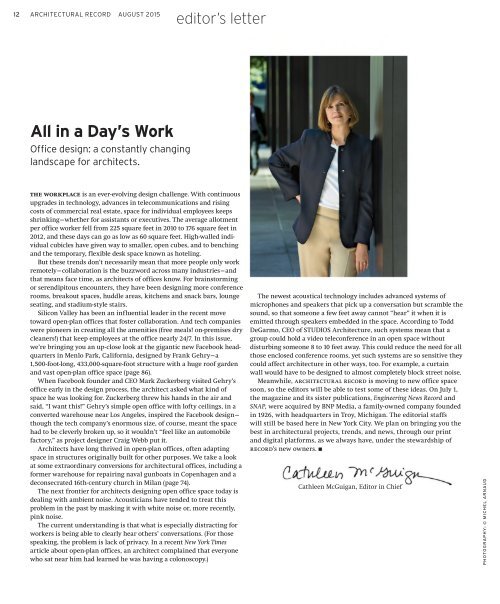Architectural Record 2015-08
You also want an ePaper? Increase the reach of your titles
YUMPU automatically turns print PDFs into web optimized ePapers that Google loves.
12<br />
ARCHITECTURAL RECORD AUGUST <strong>2015</strong><br />
editor’s letter<br />
All in a Day’s Work<br />
Office design: a constantly changing<br />
landscape for architects.<br />
the workplace is an ever-evolving design challenge. With continuous<br />
upgrades in technology, advances in telecommunications and rising<br />
costs of commercial real estate, space for individual employees keeps<br />
shrinking—whether for assistants or executives. The average allotment<br />
per office worker fell from 225 square feet in 2010 to 176 square feet in<br />
2012, and these days can go as low as 60 square feet. High-walled individual<br />
cubicles have given way to smaller, open cubes, and to benching<br />
and the temporary, flexible desk space known as hoteling.<br />
But these trends don’t necessarily mean that more people only work<br />
remotely—collaboration is the buzzword across many industries—and<br />
that means face time, as architects of offices know. For brainstorming<br />
or serendipitous encounters, they have been designing more conference<br />
rooms, breakout spaces, huddle areas, kitchens and snack bars, lounge<br />
seating, and stadium-style stairs.<br />
Silicon Valley has been an influential leader in the recent move<br />
toward open-plan offices that foster collaboration. And tech companies<br />
were pioneers in creating all the amenities (free meals! on-premises dry<br />
cleaners!) that keep employees at the office nearly 24/7. In this issue,<br />
we’re bringing you an up-close look at the gigantic new Facebook headquarters<br />
in Menlo Park, California, designed by Frank Gehry—a<br />
1,500-foot-long, 433,000-square-foot structure with a huge roof garden<br />
and vast open-plan office space (page 86).<br />
When Facebook founder and CEO Mark Zuckerberg visited Gehry’s<br />
office early in the design process, the architect asked what kind of<br />
space he was looking for. Zuckerberg threw his hands in the air and<br />
said, “I want this!” Gehry’s simple open office with lofty ceilings, in a<br />
converted warehouse near Los Angeles, inspired the Facebook design—<br />
though the tech company’s enormous size, of course, meant the space<br />
had to be cleverly broken up, so it wouldn’t “feel like an automobile<br />
factory,” as project designer Craig Webb put it.<br />
Architects have long thrived in open-plan offices, often adapting<br />
space in structures originally built for other purposes. We take a look<br />
at some extraordinary conversions for architectural offices, including a<br />
former warehouse for repairing naval gunboats in Copenhagen and a<br />
deconsecrated 16th-century church in Milan (page 74).<br />
The next frontier for architects designing open office space today is<br />
dealing with ambient noise. Acousticians have tended to treat this<br />
problem in the past by masking it with white noise or, more recently,<br />
pink noise.<br />
The current understanding is that what is especially distracting for<br />
workers is being able to clearly hear others’ conversations. (For those<br />
speaking, the problem is lack of privacy. In a recent New York Times<br />
article about open-plan offices, an architect complained that everyone<br />
who sat near him had learned he was having a colonoscopy.)<br />
The newest acoustical technology includes advanced systems of<br />
microphones and speakers that pick up a conversation but scramble the<br />
sound, so that someone a few feet away cannot “hear” it when it is<br />
emitted through speakers embedded in the space. According to Todd<br />
DeGarmo, CEO of STUDIOS Architecture, such systems mean that a<br />
group could hold a video teleconference in an open space without<br />
disturbing someone 8 to 10 feet away. This could reduce the need for all<br />
those enclosed conference rooms, yet such systems are so sensitive they<br />
could affect architecture in other ways, too. For example, a curtain<br />
wall would have to be designed to almost completely block street noise.<br />
Meanwhile, architectural record is moving to new office space<br />
soon, so the editors will be able to test some of these ideas. On July 1,<br />
the magazine and its sister publications, Engineering News <strong>Record</strong> and<br />
SNAP, were acquired by BNP Media, a family-owned company founded<br />
in 1926, with headquarters in Troy, Michigan. The editorial staffs<br />
will still be based here in New York City. We plan on bringing you the<br />
best in architectural projects, trends, and news, through our print<br />
and digital platforms, as we always have, under the stewardship of<br />
record’s new owners. ■<br />
Cathleen McGuigan, Editor in Chief<br />
PHOTOGRAPHY: © MICHEL ARNAUD


















